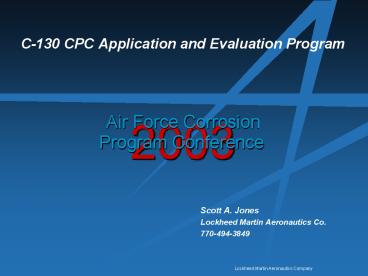C-130 CPC Application and Evaluation Program - PowerPoint PPT Presentation
1 / 23
Title:
C-130 CPC Application and Evaluation Program
Description:
Sloping Longeron / FS737 End Fitting / Flyswatter Fitting. Lockheed Martin Aeronautics Company ... WL200 Longeron. Lockheed Martin Aeronautics Company. C-130 ... – PowerPoint PPT presentation
Number of Views:508
Avg rating:3.0/5.0
Title: C-130 CPC Application and Evaluation Program
1
C-130 CPC Application and Evaluation Program
Air Force Corrosion
2003
Program Conference
- Scott A. Jones
- Lockheed Martin Aeronautics Co.
- 770-494-3849
2
OVERVIEW
- C-130 CPC Application and Evaluation Program
- Objectives
- C-130 Treatment Areas
- CPC Products Applied
- Observations/Characterizations
- Additional On-Aircraft CPC Evaluations
- Summary
3
OBJECTIVES
- Study the feasibility of using commercially
available CPC's on C-130 structure to prevent
and/or reduce corrosion and associated repair or
replacement costs. - Criteria used to gage a successful CPC product
will be its ability to prevent or reduce surface
corrosion and dissimilar metal corrosion at
aluminum structure/steel fastener interfaces.
4
OBJECTIVES
- Also, the CPC product must be capable of wicking
into crevices, lap joints, and/or faying
surfaces. - In addition, it must be compatible with the
current finish system, specifically primers and
topcoats, and should be durable to allow for
extended reapplication intervals.
5
OBJECTIVES
- Data to be documented from this program includes
- Initial condition of areas to be treated with
CPC's - Surface preparation requirements
- CPC application procedures including equipment
needs - Inspection procedures
- Reapplication intervals
- Removal requirements
- Effectiveness
6
C-130 TREATMENT AREAS
- C-130 Corrosion Prone Areas Treated With CPCs
- Sloping Longerons including FS737 End Fitting and
Flyswatter Fitting (Item 5) - BL20 Longerons (Item 7)
- FS517 and FS597 MLG Beams / Frames (Item 9)
- WL200 Longerons (Item 10)
- Elevator Torque Tubes (Item 12)
- Paratroop Door Longerons (Item 23)
7
C-130 TREATMENT AREAS
Sloping Longeron / FS737 End Fitting / Flyswatter
Fitting
8
C-130 TREATMENT AREAS
BL20 Longerons
9
C-130 TREATMENT AREAS
FS517 and FS597 MLG Beams
10
C-130 TREATMENT AREAS
WL200 Longeron
11
C-130 TREATMENT AREAS
Elevator Torque Tube
12
C-130 TREATMENT AREAS
Paratroop Door Longeron
13
CPC PRODUCTS APPLIED
- CPC Vendor Participants and Products Applied
- Dinol, Inc. (Chemetall Oakite) Dinitrol AV 15
- Zip-Chem Products Cor-Ban 35 and Cor-Ban 22
- Corrosion Technologies Corp. CorrosionX
Aviation - LPS Laboratories, Inc. Procyon, LPS 2, and LPS
3 - Cortec Corporation VCI-368 and VCI-396
14
CPC PRODUCTS APPLIED
CPC Products Applied by Location on C-130s
15
OBSERVATIONS
Thin, oily, penetrating CPC products are easily
washed away, which leave exposed surfaces clean.
With periodic reapplication, its believed
protection is still present in joints where voids
in finishes or sealant may be present.
(CorrosionX Aviation, LPS 2)
16
OBSERVATIONS
- Soft, non-hardening CPC products tended to
collect dirt and debris. - Visually unpleasing
- Wear or abrasion of protective finishes
- Possible galvanic interaction of trapped debris
and substrate - Their use is better suited for enclosed areas.
(Cor-Ban 22, VCI-368, LPS 3)
17
OBSERVATIONS
Hard-film CPC products applied correctly and not
influenced by incompatible fluids were easily
washed. This allowed visual inspections to be
performed through the CPC coating.
(Cor-Ban 35, AV 15, LPS Procyon)
18
OBSERVATIONS
Hard-film CPC products applied too thick,
softened by hydraulic fluid, or softened by other
CPCs became tacky. They then had the same
physical characteristics of soft, non-hardening
CPCs.
19
OBSERVATIONS
CPCs are not resistant to UV light and therefore
are not recommended for long-term exterior
applications.
20
OBSERVATIONS
CPCs did not always prevent corrosion from
occurring, but corrosion was visible through the
coating.
21
ADDITIONAL ON-AIRCRAFT CPC EVALUATIONS
- NAVAIR Pax River CPC Testing (MIL-C-81309 and
Commercial Types) - Lab testing complete.
- Best candidates to be applied on C-130, H-60,
F-14, and EA-6B. - One F-14 treated with CorrosionX Aviation.
- One E-2 and one C-2 aircraft treated with
CorrosionX and AV 15 during depot maintenance at
North Island. Dinitrol AV 15 used under floor
boards and sill areas, CorrosionX Aviation fogged
into tail areas. - Sabena Technics CIC Application for BAF C-130s
- CICs applied to entire aircraft during D-check
(every 6 years). - CPCP specified areas inspected and CICs
reapplied periodically. - Had been using Dinitrol AV 8 and AV 30.
- Beginning to use Dinitrol AV 15 and Zip-Chem
Cor-Ban 35.
22
SUMMARY
- Final Report Submitted August 2002
- Recommended Application Procedures
- Cleaning
- Application
- Inspection
- Reapplication
- Removal
- Usage Guidance Based On Observations
- Effectiveness of these CPCs was dependent on
frequent reapplications for some and/or timely
maintenance to touch-up missing or damaged
coatings for others. - No single CPC was identified as a stand out
performer for all treatment areas due to
differences in their physical characteristics.
23
C-130 CPC PROGRAM
Questions?
Completed CPC Application































